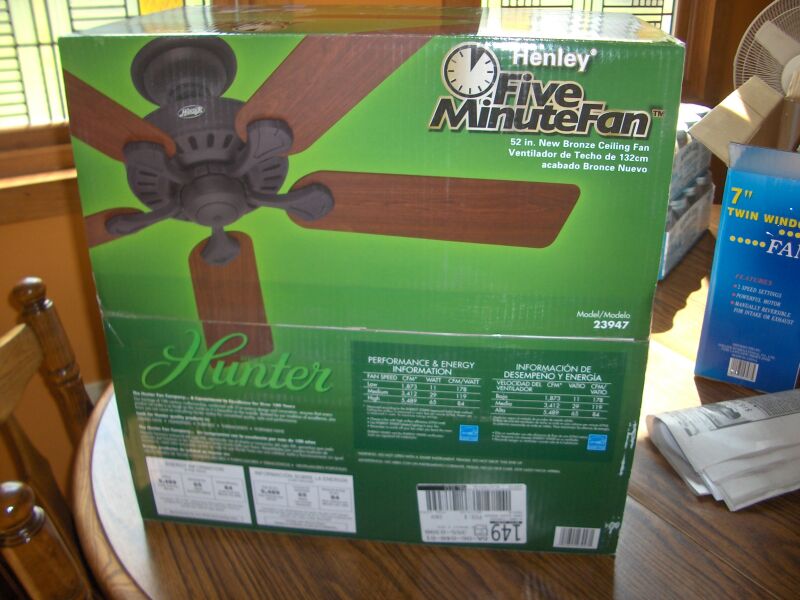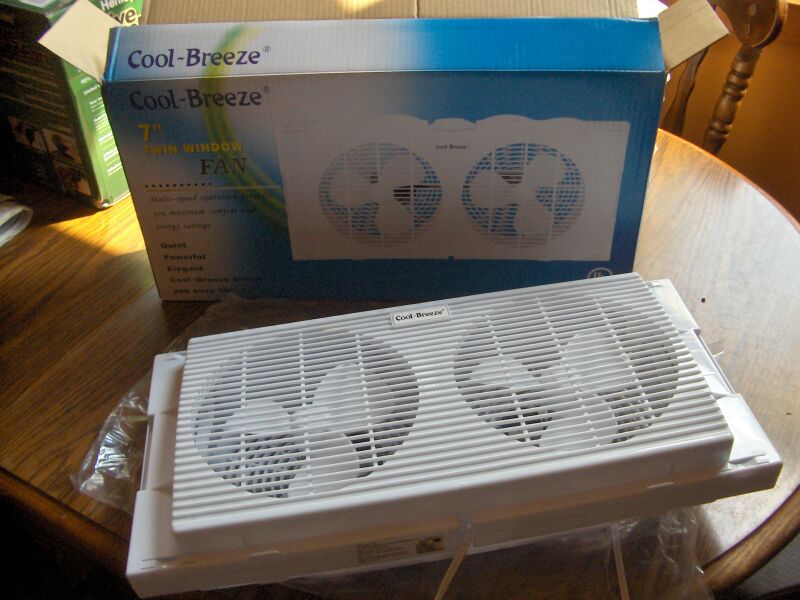
 |
|
|
#1 |
|
Administrator
Join Date: Aug 2008
Location: Germantown, WI
Posts: 5,525
Thanks: 1,162
Thanked 374 Times in 305 Posts
|
This past weekend my wife need to run to Menards to pickup some canning supplies. I decided to go along and that usually means me finding things here and there to buy.
Well, I did end up finding a couple things. Amongst them was a ceiling fan for my kitchen, the only room in the house with a 10ft ceiling and no fan. Pretty much every other room has ceiling fans. Last year I did a stratification test and the temperature at the top of the room versus the counter level was 4-5 degrees! So, thats when I decided that I needed a fan in there.  I also picked up one of these little fans for the upstairs. Since we don't have AC, we rely on cooling the house down at night to keep it cool during the day. This means we have to be able to move air through the house. When the temperature differential is high enough, regular convection works just great. However, if the temperature doesn't drop enough at night we could be stuck with a warm/hot house the next day. So, I picked up one of these to see how they work. So far, I haven't noticed a big temperature difference from using it.  |
|
|

|
|
|
#2 |
|
Helper EcoRenovator
Join Date: Apr 2009
Posts: 33
Thanks: 0
Thanked 0 Times in 0 Posts
|
I'm frequently saddened when I see people with air conditioners blazing, but a ceiling fan turned off.... air movement goes a long ways towards adding comfort and saves $$
|
|
|

|
|
|
#3 |
|
Helper EcoRenovator
Join Date: Jan 2009
Posts: 75
Thanks: 3
Thanked 1 Time in 1 Post
|
no kidding. It is 79 degF in my house right now, and that's because it has started to cool of for the evening. It was 83 in the house when I got home, with the fans on, it was not a big deal. When it's just me, I am hard pressed to run the AC, so the AC may not be run again this year!
|
|
|

|
|
|
#4 |
|
Apprentice EcoRenovator
Join Date: Aug 2009
Posts: 123
Thanks: 14
Thanked 1 Time in 1 Post
|
I personally hate A/C... it makes me feel all congested and stuffy, and even though the air is technically dried, it feels wet to me. I don't really like it much, at all.
That said, there are days were I don't think I'd mind it as much, but then, there are other options, as well, like evaporative cooling, which are quite easy to implement when necessary. You could just as easily put a bucket of cold water in front of a box fan in the window blowing air into the room, and that would make a discernible difference in just a few minutes. Alternatively, dry ice is cheap as well, and you could buy a 1-2$ block of it, put it in front of a fan, and blow the cold air around with the fan, somewhere upstairs. By the time the dry ice dissipated completely, you'd have colder air settling in the lower parts of your house, which you could then circulate with other fans. |
|
|

|
|
|
#5 |
|
Apprentice EcoRenovator
Join Date: Aug 2009
Posts: 123
Thanks: 14
Thanked 1 Time in 1 Post
|
Also - now that I'm thinking about cooling again -
If you happen to have a cold water source, or you don't pay for water (if you live in the country, and have a well) you can easily source a used car radiator that has been cleaned/brazed cheaply, and add it to your existing HVAC system. Piping cold water through it, then blowing through it with your normal HVAC blower (probably a part of your heater) will easily cool your home like A/C, without the electric/fuel bill. Natural well water can be as cold as 55*F, and you can allow/restrict water flow as much as you like to fine tune the temperature gradient. If you have access to running cold water, such as a stream, and there is a section of it that is above your home (up a hill or something), you could use gravity to drop the water through a DIY line into your radiator, which would also save you the electricity of the pump running to keep water flowing. Ideally, if you have to run a pump, you'll keep a bulk tank with a level switch, which pumps cold water into the tank, slowly drains it through the radiator (Flow restriction happens on the outlet side of the radiator, so that it stays full of water), then when the level gets too low, it turns the pump on to refill the tank again. In this way, you can fine tune the water flow to keep from wasting energy by constantly pumping water and then not using it's full cooling potential before discarding it. |
|
|

|
|
|
#6 | |
|
Supreme EcoRenovator
Join Date: Oct 2008
Location: Austin, TX
Posts: 1,154
Thanks: 14
Thanked 257 Times in 241 Posts
|
Quote:
__________________
To my surprise, shortly after Naomi Wu gave me a bit of fame for making good use of solar power, Allie Moore got really jealous of her... |
|
|
|

|
|
|
#7 |
|
Apprentice EcoRenovator
Join Date: Aug 2009
Posts: 123
Thanks: 14
Thanked 1 Time in 1 Post
|
We did something similar to that in a trailer park that I lived in when my neighbors heater went out, and the repair people wouldn't come out for like a week.
Once again, I grabbed a radiator from an old car, flushed it out, ran hoses in through a window, and put a small box fan behind it. Outside, we got a decent sized flat pan and filled it with water, then put a pane of glass over it. The heat caused the water to thermocycle through the system during the day, and they only had to use an electric heater at night. By hanging burlap sacks over the door to the hallway, they were able to keep the living room and kitchen a "livable" temperature with very little heating ability. It really does work out well. If you're going to be using water to do this, though, please make sure you restrict the water flow so that there is no more water flowing than what is necessary to extract your heat from it. It literally only takes a quickly dripping line to create enough water flow to keep the radiator fairly warm, depending on the temp of the water to begin with. Anything more, you're just wasting water and heat energy. |
|
|

|
|
|
#8 |
|
Supreme EcoRenovator
Join Date: Oct 2008
Location: Austin, TX
Posts: 1,154
Thanks: 14
Thanked 257 Times in 241 Posts
|
My plan for control is to leave the fans running on full power and adjust the water to control temperature. I'll probably rig up a solenoid to the faucet lever and connect it to a cheap thermostat I once modified for a glue curing machine.
__________________
To my surprise, shortly after Naomi Wu gave me a bit of fame for making good use of solar power, Allie Moore got really jealous of her... |
|
|

|
|
|
#9 | |
|
Apprentice EcoRenovator
Join Date: Aug 2009
Posts: 123
Thanks: 14
Thanked 1 Time in 1 Post
|
Quote:
Since the Yconnectors have valves on them, you could control just the valve on your heater's side of the Y, and then close the other valve to stop water from flowing where you don't want it, until you need to use that faucet for something, then flip open the other valve. One problem you might run into is that the heat exchange from a higher water flow won't happen instantly, so you'll need to figure out what water flow will net you the fastest heat exchange for the least energy, else you'll just be opening the valve too far and wasting energy and water again. OTOH - A more precise way to control the temps, since water temp is a constant, is to control the amount of water flowing out, instead of in. If you could put a solenoid controlled valve on the outlet side of the heat exchanger, you'd have the ability to turn the faucet all the way on, and just dump a large section of the water in the unit until the temps reach optimal again, which only takes a few seconds, as opposed to a few minutes for the water to conduct it's energy through other water and into the metal. |
|
|
|

|
|
|
#10 |
|
Helper EcoRenovator
Join Date: Sep 2008
Posts: 34
Thanks: 0
Thanked 0 Times in 0 Posts
|
when I put up fans in our old apt I spent hours at menards comparing cfm's and energy usage charts. Finaly I settled on a low profile hunter that was I think about 68 inches in diameter but it actualy had a really low power useage and moved more air on low than alot of the 36-42" fans did on medium or even high.
The disapointing thing was that this particular fan had an IR remote for the fan and the light. The controller unit in the fan itself had issues where it would turn off the fan, or turn on the lights at 3 in the morning. We were moving out soon so I just had the complex put up one of their cheap ones and I took it back. I'd definatly get a similar non IR unit in the future though. made heating and cooling so easy. |
|
|

|
 |
| Thread Tools | |
| Display Modes | |
|
|